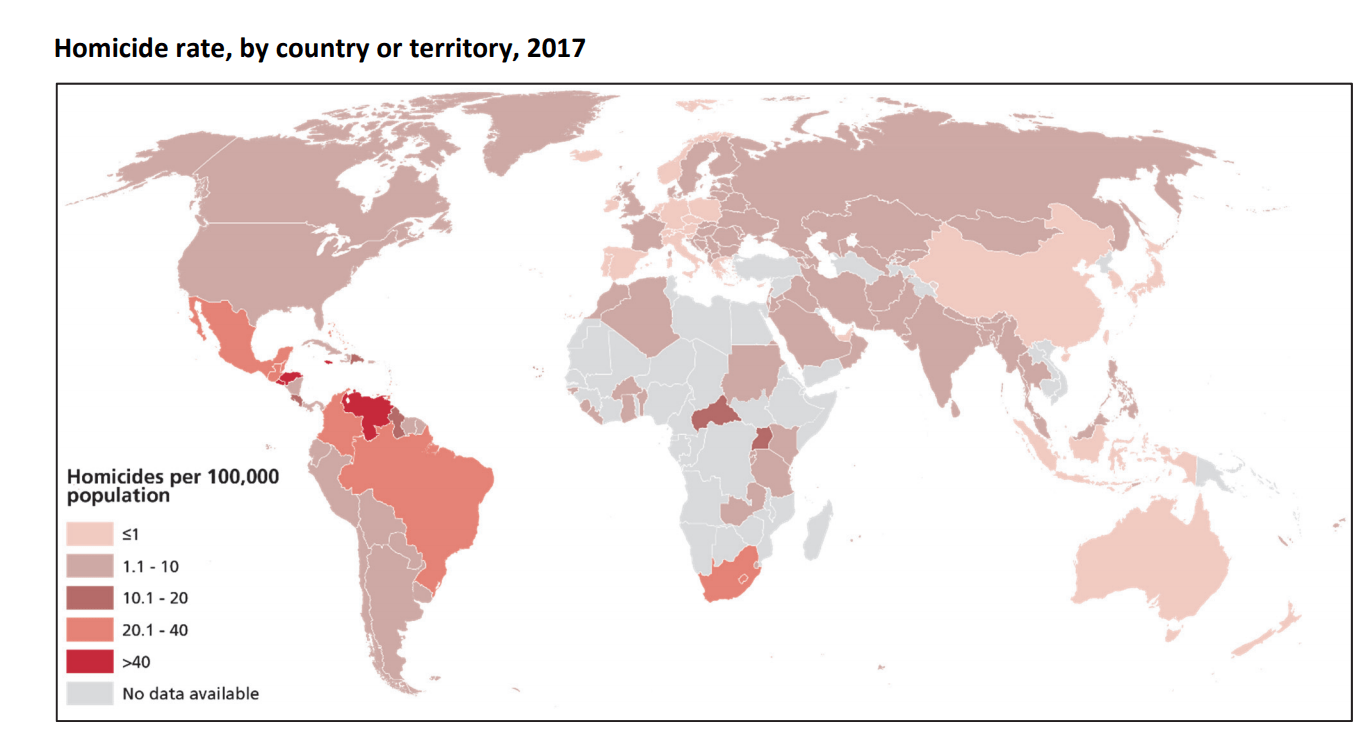Armed conflicts are becoming deadlier as violence intensifies, but a new United Nations (UN) report reveals that actually, intentional homicide kills far more people.
In fact, according to the hefty Global Study on Homicide 2019, published this week by the UN Office on Drugs and Crime (UNODC), crime kills significantly more people than armed conflict and terrorism combined. While armed conflict killed 89,000 people in 2017 and terrorism killed 26,000, crime ended the lives of 464,000 people that year.
This data is important to track, the report says, because homicide affects not just the victim but also the victim’s family and community. It creates a violent environment that is harmful to society, the economy and the world at large.
Homicide rates are also the first indicator for measuring progress toward the first target under the UN’s Sustainable Development Goal (SDG) 16: to “significantly reduce all forms of violence and related death rates everywhere.” It also affects nearly all the other SDGs, the report notes, including no poverty, good health, quality education, gender equality, decent work and economic growth, reduced inequalities, sustainable cities, climate action and life on land.
Overall, the number of people who have died from violent crime has increased over the last 25 years, the report says. Compare the 464,000 recorded homicide victims in 2017 to the nearly 396,000 in 1992.
Even in just two years – from 2015 to 2017 – the number of homicide victims worldwide increased by 4 percent, or 19,000 people. This means that if current trends hold, we will not achieve SDG 16 by 2030, the report says.
However, the risk of homicide has actually decreased, because the global population has grown faster than the increase in recorded homicides. Whereas the global homicide rate was 7.2 homicides per 100,000 people in 1992, it was 6.1 in 2017.
Just tracking the global average, though, masks big differences between regions, the report says. For example, two regions had homicide rates that exceed the global average of 6.1 per 100,000 people. Those were the Americas, which recorded its highest homicide rate (17.2) since reliable records began in 1990, and Africa (13.0).
Asia, which accounts for 60 percent of the global population, recorded the lowest rate (2.3); although, in absolute numbers of homicides, it had the third most (over 104,000) behind Africa (nearly 163,000) and the Americas (over 173,000). The rates in Oceania and Europe were also below the global average, at 2.8 and 3.0 respectively. However, the report notes that there are still significant gaps in reliable data for African countries, and Pacific countries may be underreporting crime.
Even within regions, there are large discrepancies. For example, in Central America, the highest national homicide rate – 62.1 – was more than seven times the lowest. The report attributes this disparity between countries to differences in socioeconomic development, the rule of law, demographics, political instability as well as organized crime groups and gangs.
In Southeast Asia, too, the highest national homicide rate is 44 times the lowest. That’s because some countries are dealing with organized crime, terrorist activity, lower levels of socioeconomic development and higher rates of impunity. Meanwhile, Singapore has one of the lowest homicide rates in the world, which the country attributes to strong rule of law, good governance, low levels of corruption, policies that lessen social segregation as well as long-term investments in universal education and health care.
According to the report, organized crime alone is a major source of homicide around the world. Since 2000, organized crime has been responsible for about the same number of killings as all armed conflicts combined in the same time period – about 65,000 per year or roughly 1 million from 2000 to 2017. The report estimates that in 2017, up to 19 percent of all homicides in the world were related to organized crime and gangs.
In addition, the report notes that more than half of the 464,000 homicides in 2017 were carried out with guns, compared to only one-fifth that involved sharp objects. Particularly in the Americas, firearms were used to perpetrate about three-quarters of homicides in 2017. These killings account for more than a quarter of all homicides in the world that year.
According to the report, some countries with high rates of firearm-related deaths tend to have high rates of intentional homicide, suggesting a link between guns and high homicide levels. Meanwhile, in countries where killings are mostly carried out with sharp objects, homicide rates tend to be low.
Additionally, about 81 percent of homicide victims in the world in 2017 were men and boys, while more than 90 percent of the suspects were men. However, by far, women and girls are the primary victims of intimate partner and family-related homicide, particularly in Asia and Africa, where an estimated 20,000 and 19,000 women and girls, respectively, were killed by their partner or family member in 2017.
The good news is that understanding the drivers and facilitators of homicide – including organized crime, gender stereotypes, inequality, unemployment, political instability, firearms and drugs – can help countries adopt policies that bring down the rate of violent crime, the report says.
“I hope that the research and analysis contained in the study are used in this spirit,” writes Yury Fedotov, executive director of UNODC, in the report. “Not to designate ‘murder capitals’ but to learn, understand and strengthen prevention.”
To view an interactive map that lists countries homicide rates, visit this UNDOC resource.
